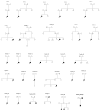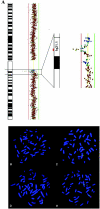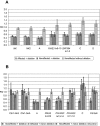Complex inheritance pattern resembling autosomal recessive inheritance involving a microdeletion in thrombocytopenia-absent radius syndrome
- PMID: 17236129
- PMCID: PMC1785342
- DOI: 10.1086/510919
Complex inheritance pattern resembling autosomal recessive inheritance involving a microdeletion in thrombocytopenia-absent radius syndrome
Abstract
Thrombocytopenia-absent radius (TAR) syndrome is characterized by hypomegakaryocytic thrombocytopenia and bilateral radial aplasia in the presence of both thumbs. Other frequent associations are congenital heart disease and a high incidence of cow's milk intolerance. Evidence for autosomal recessive inheritance comes from families with several affected individuals born to unaffected parents, but several other observations argue for a more complex pattern of inheritance. In this study, we describe a common interstitial microdeletion of 200 kb on chromosome 1q21.1 in all 30 investigated patients with TAR syndrome, detected by microarray-based comparative genomic hybridization. Analysis of the parents revealed that this deletion occurred de novo in 25% of affected individuals. Intriguingly, inheritance of the deletion along the maternal line as well as the paternal line was observed. The absence of this deletion in a cohort of control individuals argues for a specific role played by the microdeletion in the pathogenesis of TAR syndrome. We hypothesize that TAR syndrome is associated with a deletion on chromosome 1q21.1 but that the phenotype develops only in the presence of an additional as-yet-unknown modifier (mTAR).
Figures





Similar articles
-
Thrombocytopenia-absent-radius syndrome in a child showing a larger 1q21.1 deletion than the one in his healthy mother, and a significant downregulation of the commonly deleted genes.Eur J Med Genet. 2012 Feb;55(2):120-3. doi: 10.1016/j.ejmg.2011.11.007. Epub 2011 Dec 8. Eur J Med Genet. 2012. PMID: 22201559
-
Thrombocytopenia-absent radius syndrome.Semin Thromb Hemost. 2011 Sep;37(6):707-12. doi: 10.1055/s-0031-1291381. Epub 2011 Nov 18. Semin Thromb Hemost. 2011. PMID: 22102274 Review.
-
Thrombocytopenia-absent radius (TAR) syndrome: a clinical genetic series of 14 further cases. impact of the associated 1q21.1 deletion on the genetic counselling.Eur J Med Genet. 2011 Sep-Oct;54(5):e471-7. doi: 10.1016/j.ejmg.2011.05.001. Epub 2011 May 13. Eur J Med Genet. 2011. PMID: 21635976
-
Prenatal diagnosis and post-mortem examination in a fetus with thrombocytopenia-absent radius (TAR) syndrome due to compound heterozygosity for a 1q21.1 microdeletion and a RBM8A hypomorphic allele: a case report.BMC Res Notes. 2013 Sep 22;6:376. doi: 10.1186/1756-0500-6-376. BMC Res Notes. 2013. PMID: 24053387 Free PMC article.
-
New insights into the genetic basis of TAR (thrombocytopenia-absent radii) syndrome.Curr Opin Genet Dev. 2013 Jun;23(3):316-23. doi: 10.1016/j.gde.2013.02.015. Epub 2013 Apr 17. Curr Opin Genet Dev. 2013. PMID: 23602329 Review.
Cited by
-
Beware of Hemizygous Deletions That May Unmask Deleterious Variants.Mol Syndromol. 2012 Aug;3(2):45-46. doi: 10.1159/000339564. Epub 2012 Jul 5. Mol Syndromol. 2012. PMID: 23112749 Free PMC article. No abstract available.
-
Fine mapping of the 1p36 deletion syndrome identifies mutation of PRDM16 as a cause of cardiomyopathy.Am J Hum Genet. 2013 Jul 11;93(1):67-77. doi: 10.1016/j.ajhg.2013.05.015. Epub 2013 Jun 13. Am J Hum Genet. 2013. PMID: 23768516 Free PMC article.
-
Non-coding genetic variants in human disease.Hum Mol Genet. 2015 Oct 15;24(R1):R102-10. doi: 10.1093/hmg/ddv259. Epub 2015 Jul 7. Hum Mol Genet. 2015. PMID: 26152199 Free PMC article. Review.
-
Comparative analysis of copy number detection by whole-genome BAC and oligonucleotide array CGH.Mol Cytogenet. 2010 Jun 29;3:11. doi: 10.1186/1755-8166-3-11. Mol Cytogenet. 2010. PMID: 20587050 Free PMC article.
-
Radial Ray Anomaly with Associated Ventricular Septal Defect - Case Report with Review of Literature.J Ultrason. 2023 Feb 28;23(92):35-38. doi: 10.15557/JoU.2023.0007. eCollection 2023 Jan. J Ultrason. 2023. PMID: 36880000 Free PMC article.
References
Web Resources
-
- BACPAC Resources, http://bacpac.chori.org/pHumanMinSet.htm
-
- Database of Genomic Variants, http://projects.tcag.ca/variation/
-
- Ensembl, http://www.ensembl.org/
-
- Gene Expression Omnibus (GEO), http://www.ncbi.nlm.nih.gov/geo/
-
- Max Planck Institute for Molecular Genetics: Molecular Cytogenetics Group, http://www.molgen.mpg.de/~abt_rop/molecular_cytogenetics/Protocols.html
References
-
- Ballmaier M, Schulze H, Strauß G, Cherkaoui K, Wittner N, Lynen S, Wolters S, Bogenberger J, Welte K (1997) Thrombopoietin in patients with congenital thrombocytopenia and absent radii: elevated serum levels, normal receptor expression, but defective reactivity to thrombopoietin. Blood 90:612–619 - PubMed
-
- Letestu R, Vitrat N, Massé A, Couedic J-PL, Lazar V, Rameau P, Wndling F, Vuillier J, Boutard P, Plouvier E, et al (2000) Existence of a differentiation blockage at the stage of a megakaryocyte precursor in the thrombocytopenia and absent radii (TAR) syndrome. Blood 95:1633–1641 - PubMed
Publication types
MeSH terms
LinkOut - more resources
Full Text Sources
Other Literature Sources
Medical
Molecular Biology Databases

